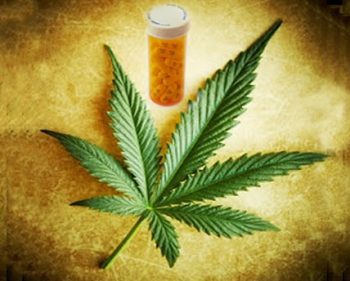By Marco Torres
Guest writer for Wake Up World
From 2000 to 2015, half a million people died from prescription drug overdoses, and stories continue to roll in daily about the lives claimed by prescription and non-prescription drug overdoses. Cannabis, however, is not only excluded from the drug overdose list, it has actually been shown to reduce the use of dangerous prescription drugs.
Raw cannabis is considered by many experts as a dietary essential. As a powerful anti-inflammatory and antioxidant, some classify it as one of the most important plants on earth. The biggest benefits from the plant may come not by smoking it, but rather by consuming it in its raw and natural form.
“If cannabis were discovered in an Amazon rainforests today, people would be clambering to make as much use as they could out of the potential benefits of the plant,” said Donald L. Abrams, MD, Chief of Hematology and Oncology at San Francisco General Hospital and Professor of Medicine at the University California. Dr. Abrams is widely known for his research on medical cannabis applications. “Unfortunately, it carries with it a long and not so long history of being a persecuted plant,” he added.
[pro_ad_display_adzone id=”110028″]
“The potential for addiction and health risks associated with using multiple Scheduled drugs places additional direct monetary and health costs on patients and healthcare systems due to an increased number of side effects, risky drug interactions, dependency, and overdose”, stated University of New Mexico researchers Jacob Miguel Vigil Ph.D and Sarah See Stith Ph.D, who co-authored a study entitled Effects of Legal Access to Cannabis on Scheduled II-V Drug Prescriptions, which was released in the July issue of the Journal of American Medical Directors Association.
The study resulted from insights provided by co-investigator Dr. Anthony Reeve, a pain specialist from the Industrial Rehabilitation Pain Clinics, Albuquerque, N.M. and also one of the first physicians to authorize the use of cannabis for patients with chronic pain in the state of New Mexico. Reeve observed that a number of his patients were coming back to see him less frequently after enrolling in the New Mexico Medical Cannabis Program (MCP), and who also, anecdotally, often claimed not only to be reducing their pain medications but also other types of prescription medications as well.
Related reading: Study: Marijuana Decreases Death Rates from Pain Killers by Over 30 Percent
In the resulting historical cohort study, the researchers compared individuals that enrolled in the medical cannabis program to individuals with a similar diagnosis that chose not to enroll in the medical cannabis program but were offered the same authorization, to measure the effect of enrollment in a state-authorized United States’ MCP on Scheduled II-V drug prescription patterns. They compared 83 chronic pain patients, who enrolled in the New Mexico Medical Cannabis Program during a five+ year period from April 2010 to October 2015, to 42 non-enrolled patients over a 24 month period (starting 6 months prior to enrollment for the MCP patients) using the Prescription Monitoring Program.
Using outcome variables including baseline levels and pre- and post-enrollment monthly trends in the numbers of drug prescriptions, distinct drug classes, dates prescription drugs were filled, and prescribing providers, the researchers found that 28 cannabis program enrollees (34 percent) and one comparison group patient (2 percent) ceased the use of all scheduled prescription medications by the last six months of the observation period.
Age and gender-adjusted regressions show that, although no statistically significant differences existed in pre-enrollment levels and trends, the post-enrollment trend among MCP patients is statistically significantly negative for all four measures of scheduled drug medication usage, while the post-enrollment trend is zero among the comparison group. The cannabis program enrollees showed statistically significantly lower levels across all four measures in comparison to the non-enrollees by 10 months post-enrollment. The researchers hypothesize that legal access to cannabis may reduce the use of multiple classes of dangerous prescription medications in certain patient populations.
Related reading: US States With Medical Marijuana Laws Have Lower Rates of Opioid-Related Deaths, Study Finds
Said Vigil, the senior author and Associate Professor in the Department of Psychology:
“Our current opioid epidemic is the leading preventable form of death in the United States, killing more people than car accidents and gun violence. No one has ever died from smoking too much cannabis. Therefore, the relative safety and efficacy of using cannabis in comparison to that of the other scheduled medications should be taken by the health providers and legislators, and may very well to have been considered by the patients in our study.”
The authors state that increased patient access to MCPs could impact prescription drug activity in numerous ways.
“Potentially, MCPs might drive increased prescribing of medications as a result of side effects of cannabis use, including agitation or somnolence. Alternatively, access to cannabis could lead to a reduction in scheduled prescription drug use, if it treats patients’ underlying condition(s) more effectively than scheduled drugs requiring a prescription.”
The researchers are currently employing naturalistic studies to identify how older patients use and are affected by opioids, benzodiazepines and medical cannabis for treating a variety of significant — and societally-expensive — health conditions.
For more information on the medicinal applications of cannabis, please visit Wake Up World’s cannabis research page.
Recommended articles by Marco Torres:
- Hemp Can Free Us From Oil, Prevent Deforestation and Cure Cancer – So Why Is It Illegal?
- The Endocannabinoid System and How THC Cures Cancer
- Cannabis Treats Anxiety, Depression and Activates Brain Pathways That Regulate Emotional Behavior
- Study Shows The Therapeutic Effects of Marijuana on Autistic Children
- Cannabis Oil Cures Infant of Cancer, Dissolves Inoperable Tumor
- 5 Diseases Proven To Respond Better To Cannabis Than Prescription Drugs
- Another Reason Marijuana is Illegal: It Prevents the Spread of HIV
- 4 Diseases That Can Be Reversed Naturally Without Pharmaceutical Drugs
- 5 Reasons to Juice Rather Than Smoke Cannabis
- Woman Shrinks Inoperable Mass, Heals Her Thyroid Disease With Cannabis Oil
- Still Believe Nature Got It Wrong? Top 10 Health Benefits of Marijuana
- Study: Marijuana Decreases Death Rates from Pain Killers by Over 30 Percent
About the author:
Marco Torres is a research specialist, writer and consumer advocate for healthy lifestyles. He holds degrees in Public Health and Environmental Science and is a professional speaker on topics such as disease prevention, environmental toxins and health policy. This article republished from Prevent Disease.
[pro_ad_display_adzone id=”110027″]







